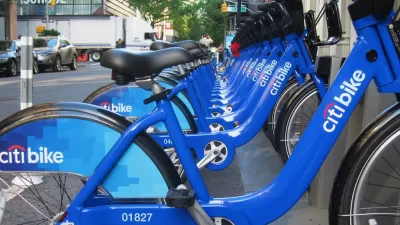Portland (top city in 2012)? Minneapolis (top city in 2010)? No, it's the Big Apple! New York City leaped from #7 in 2012 to the top spot this year for cities with populations of 100,000 or greater.

"Bicycling Editor-in-Chief Bill Strickland said today’s [Sept. 3] announcement is 'a surprise to many cycling insiders,' with New York’s recent track record as a role model for other American cities putting it over the top.," writes Stephen Miller of Streetsblog NYC.
“New York City is on the leading edge of how cities can use bicycles to improve the quality of life for everyone,” (Strickland) said. ”We think it’s going to influence cities not just around the country, but around the world.”
Credit goes largely to the former Bloomberg administration, particularly to former Transportation Commissioner Janette Sadik-Khan. "DOT added more than 366 miles of bike lanes, including 31 miles of protected bike paths [PDF], during the last seven years of the Bloomberg administration," adds Miller.
Indeed, protected bike lanes appeared to have scored particularly high this year, sending a message to all cities who wish to be viewed as "bicycle-friendly". The presence of bike share also appeared to be a major factor.
“As ‘Bicycling’ magazine notes," writes Pete Donohue of the Daily News, "New York has — against all odds — embraced, and has been transformed by, a mode of transportation which is inexpensive, burns no fuel, emits no carbon, helps tackle obesity, connects people to their communities and — let’s face it — brings joy,” said DOT Commissioner Polly Trottenberg.
Michael Andersen, Bike Portland's news editor, lists the rankings for 2014 and 2012, after noting, "It’s our lowest ranking in 20 years. Bicycling named Portland as the nation’s best bike city in 1999, 2001, 2006, 2008 and 2012."
1. New York
2. Chicago
3. Minneapolis
4. Portland
5. Washington
6. Boulder, Colo.
7. San Francisco
8. Seattle
9. Fort Collins, Colo.
10. Cambridge, Mass.
Here’s the previous Bicycling ranking, from 2012:
1. Portland
2. Minneapolis
3. Boulder, Colo.
4. Washington
5. Chicago
6. Madison
7. New York City
8. San Francisco
9. Eugene
10. Seattle
And America's "second city" also occupies that rank from Bicycling's perspective. "The magazine cited [Mayor Rahm] Emanuel’s plan to add 100 miles of protected bike lanes by 2015; the city’s $60 million Navy Pier flyover, which features an elevated bicycle-pedestrian path along the Lakefront Trail; and a “bike-share arms race with New York City," writes Rosalind Rossi, transportation reporter for the Chicago Sun-Times.
Steve Brandi of the (Minneapolis) StarTribune explains why his city dropped to #3 and why New York and Chicago jumped to #1 and #2 respectively.
It's been late to the parade on implementing protected bike lanes, the hottest new technique for trying to persuade people to ride instead of drive. New York and Chicago jumped to the top of the list after recently adding miles of such lanes -- in which something more substantial than painted lines separate bikes from drivers.
Correspondent's note: Sorry, I could not find a link to the Bicycling Magazine article at press time. Please feel free to add it under "Comments".
FULL STORY: Trottenberg: NYC Won’t Be Dethroned as America’s “Best Biking City”

Planetizen Federal Action Tracker
A weekly monitor of how Trump’s orders and actions are impacting planners and planning in America.

Chicago’s Ghost Rails
Just beneath the surface of the modern city lie the remnants of its expansive early 20th-century streetcar system.

San Antonio and Austin are Fusing Into one Massive Megaregion
The region spanning the two central Texas cities is growing fast, posing challenges for local infrastructure and water supplies.

Since Zion's Shuttles Went Electric “The Smog is Gone”
Visitors to Zion National Park can enjoy the canyon via the nation’s first fully electric park shuttle system.

Trump Distributing DOT Safety Funds at 1/10 Rate of Biden
Funds for Safe Streets and other transportation safety and equity programs are being held up by administrative reviews and conflicts with the Trump administration’s priorities.

German Cities Subsidize Taxis for Women Amid Wave of Violence
Free or low-cost taxi rides can help women navigate cities more safely, but critics say the programs don't address the root causes of violence against women.
Urban Design for Planners 1: Software Tools
This six-course series explores essential urban design concepts using open source software and equips planners with the tools they need to participate fully in the urban design process.
Planning for Universal Design
Learn the tools for implementing Universal Design in planning regulations.
planning NEXT
Appalachian Highlands Housing Partners
Mpact (founded as Rail~Volution)
City of Camden Redevelopment Agency
City of Astoria
City of Portland
City of Laramie



























